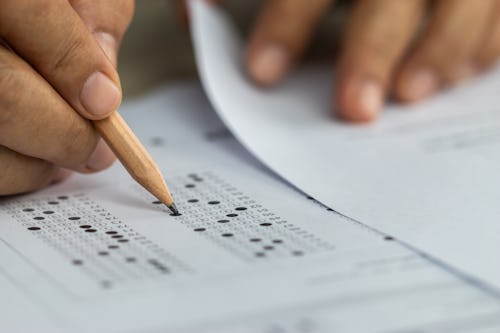
If you’re like me, all you remember about standardized testing is getting an intense cramp from writing for forever. Also, as a leftie, I got pencil smudges all over my hand. Soon, however, those memories will be nothing but a clue as to just how ancient you are. In the next few years, the SAT is going entirely digital. It’s an upgrade that nobody really asked for, but hey, gotta stay relevant somehow!
Last year, total SAT testing took a big hit. The College Board, which runs and administers the test, told Reuters that about 1.5 million students in the high school class of 2021 took the SAT, compared to 2.2 million from the class of 2020. Unsurprisingly, that drop was directly attributed to the pandemic, during which thousands of students’ SAT exams were cancelled or postponed — in some cases, multiple times.
As a result, a number of institutions turned away from entrance exams entirely. According to the nonprofit organization FairTest, an all-time high of over 1,800 schools didn’t require SAT or ACT scores for applications for the fall class of 2022.
You might think that would prompt a radical shift in how we approach college admissions. If 1,800 schools can opt for test-optional or test-blind admissions in a year, then why can’t that become the new normal? But as the pandemic has shown, hoping for improvement is a good way to be continually disappointed, because we as a society tend to try to duct-tape broken systems together instead.
And so, beginning in 2024 in the United States, and 2023 in some other countries, students will ditch pen and paper for their SATs in favor of laptops and tablets. These can be their own devices, school-issued, or provided by the College Board itself. In addition, the SAT will be shortened from three hours to two hours.
“The digital SAT will be easier to take, easier to give, and more relevant,” Priscilla Rodriguez, a vice president at the College Board, told Reuters. “We’re not simply putting the current SAT on a digital platform — we’re taking full advantage of what delivering an assessment digitally makes possible.”
Somewhat ironically, students will still have to take the SAT at a testing center. But that’s because the College Board already floated allowing at-home testing before ditching the idea over concerns about students being able to access power and reliable internet for three hours.
The College Board told The New York Times that 80% of students found digital testing less stressful in a pilot run of the program. Christal Wang, a junior, took both the digital test and the pencil test. Wang told the Times that the digital SAT had shorter reading passages requiring fewer responses, adding, “I definitely preferred that format with the shorter passages. I also felt less drained at the end.”
On one hand, it’s good if the digital format does, indeed, provide a better testing experience for students. But you know what’d be even better? Getting rid of the SAT altogether.
It’s hard to ignore that the SAT and other admissions tests discriminate against students of color and lower-income students. In 2017, the Brookings Institute reported that the gap between Black and white students’ scores remained virtually unchanged over 15 years.
The SAT claims to measure academic aptitude. It’s in the name: Scholastic Aptitude Test (which is already among the most pretentious things I’ve had the misfortune of reading). But that’s not really what the test does in practice. As Christopher Rim, founder and CEO of Command Education, wrote in an article arguing to abolish the SAT, “There is a clear link between household income and test performance. If you practice enough and have the right resources, you will see your score rise. Test prep and tutoring is a multibillion-dollar industry; those who can afford such resources will generally outperform those who do not.”
Similarly, the Brookings Institute noted, “Black and Hispanic or Latino students routinely score lower on the math section of the SAT — a likely result of generations of exclusionary housing, education, and economic policy — which too often means that, rather than reducing existing race gaps, using the test in college admissions reinforces them.” And that doesn’t magically go away when you ditch the Ticonderogas for tablets.







